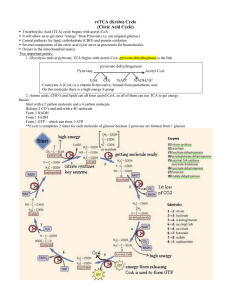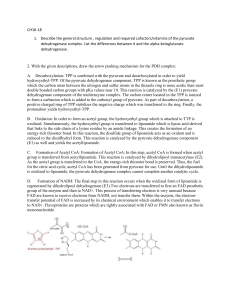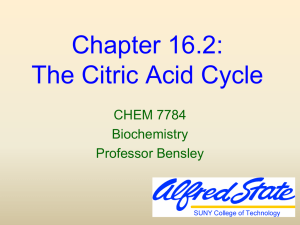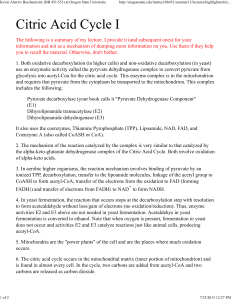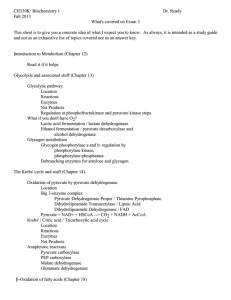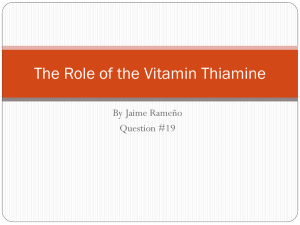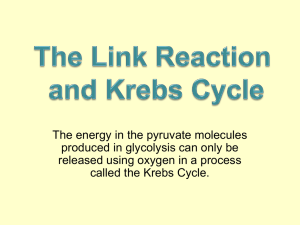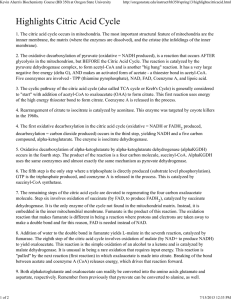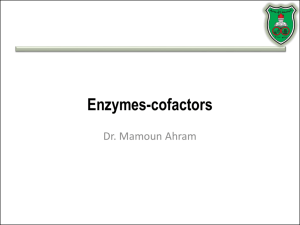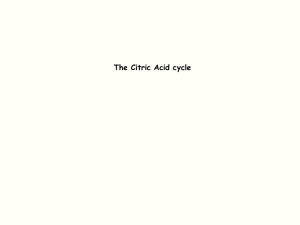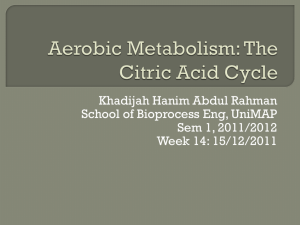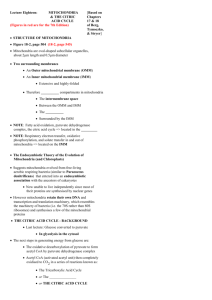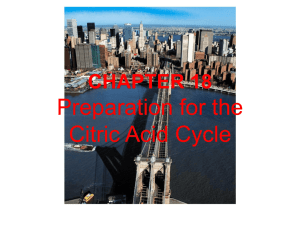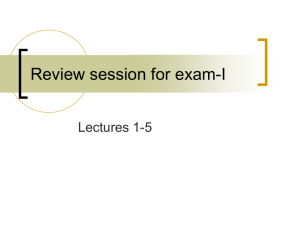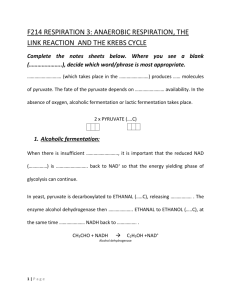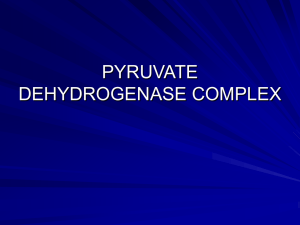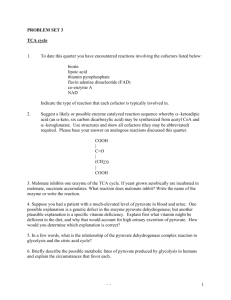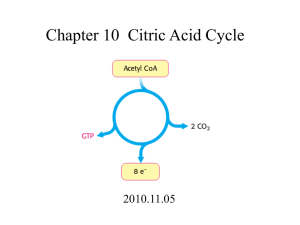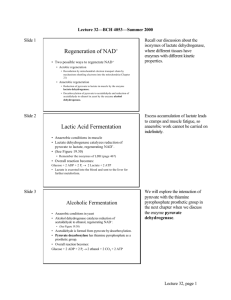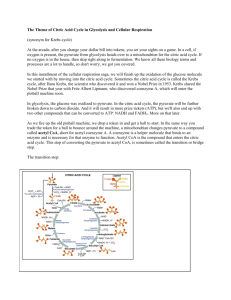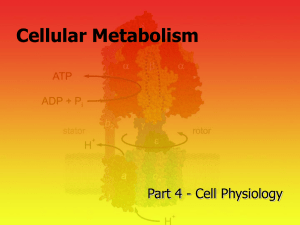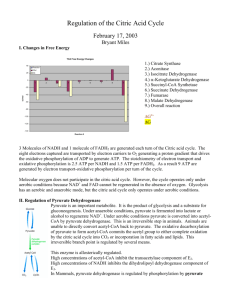Tricarboxylic Acid Cycle
advertisement
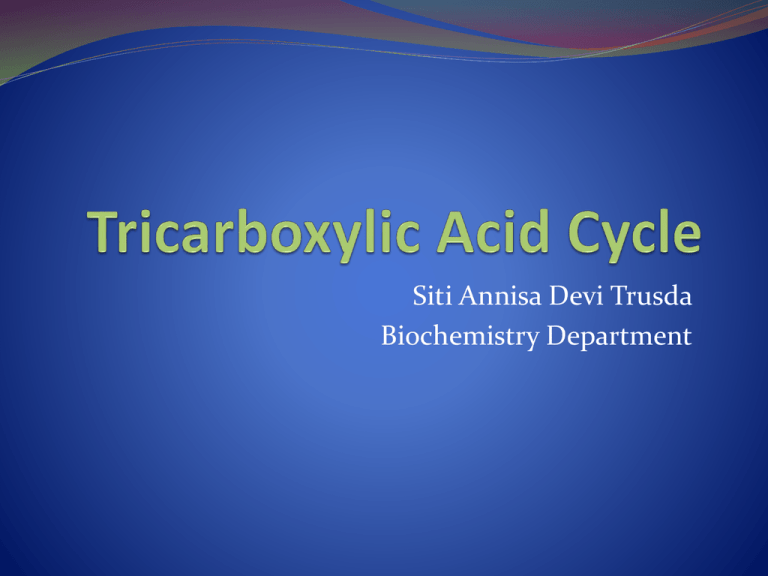
Siti Annisa Devi Trusda Biochemistry Department Overview final pathway where oxidative metabolism of CH, AA, FAcarbon skeleton : CO2 & H2O provides energy (ATP) occurs in mitochondriain close proximity to reactions of electron transport AerobicO2 required as the final electron acceptor Participates in synthetic rx/: formation of glucose from carbon skeleton of some AA Intermediates of the TCA cycle can also be synthesized by the catabolism of some amino acids a traffic circle with compounds entering and leaving as required REACTION OF THE TCA CYCLE Pyruvate, the product of glycolysis, is converted to acetyl-CoA, the starting material for the citric acid cycle, by the pyruvate dehydrogenase complex. The PDH complex is composed of multiple copies of three enzymes: pyruvate dehydrogenase, E1 (with its bound cofactor TPP); dihydrolipoyl transacetylase, E2 (with its covalently bound lipoyl group) dihydrolipoyl dehydrogenase, E3 (with its cofactors FAD and NAD). E1 catalyzes the decarboxylation of pyruvate hydroxyethyl -TPP, then the oxidation of the hydroxyethyl group acetyl group. E2 catalyzes the transfer of the acetyl group to coenzyme A, forming acetyl-CoA. E3 catalyzes the regeneration of the disulfide(oxidized) form of lipoate; electrons pass first to FAD, then to NAD. The Pyruvate Dehydrogenase Complex Requires Five Coenzymes The combined dehydrogenation and decarboxylation of pyruvate to the acetyl group of acetyl-CoA requires the sequential action of 3 different enzymes 5 different coenzymes or prosthetic groups thiamine pyrophosphate (TPP), flavin adenine dinucleotide (FAD), coenzyme A (CoA, sometimes denoted CoA-SH, to emphasize the role of the OSH group), nicotinamide adenine dinucleotide (NAD) lipoate. 4 different vitamins required in human nutrition are vital components of this system: thiamine (inTPP), riboflavin (in FAD), niacin (in NAD), and pantothenate (in CoA). Pyruvate Dehydrogenase Deficiency congenital lactic acidosis inability to convert pyruvate to acetyl CoA Pyruvate to be shunted to lactic acid via lactate dehydrogenase Severe : Neonatal death Moderate: psychomotor retardation w/ damage of cerebral cortex, basal ganglia, brainstemdeath in infancy Third form: episodic ataxia induced by Ch rich meal No treatment available ketogenic diet Mechanism of Arsenic Poisoning Arsenic inhibits enzymes that require lipoic acid as cofactor : pyruvate dehydrogenase, α-ketoglutarate dehydrogenase. Arsenite forms a stable complex with the thiol (SH) group of lipoic acidunavailable to serve as coenzyme If it binds to lipoic acid in the pyruvate dehydrogenase complex, pyruvate (and lactate) accumulate ≈ pyruvate dehydrogenase complex deficiency neurologic distrubance - death The Citric Acid Cycle Has 8 Steps 1. Formation of Citrate 2. Formation of Isocitrate via cis-Aconitate 3. Oxidation of isocitrate to α-ketoglutarate +CO2 4. Oxidation of α-ketoglutarate to succinyl coA+ CO2 5. Conversion of succinyl coA to succinate 6. Oxidation of succinate to fumarate 7. Hydration of fumarate to malate 8.Oxidation of malate to oxaloacetate Products of one turn of the citric acid cycle. At each turn of the cycle(each molecule of acetyl coA), 3 NADH (9 ATP), 1 FADH2(2 ATP), 1GTP (1 ATP), and two CO2 are released in oxidative decarboxylation reactions 12 ATP Citric Acid Cycle Components Are Important Biosynthetic Intermediates The citric acid cycle is an amphibolic pathwayboth catabolic and anabolic processes. Besides its role in the oxidative catabolism of carbohydrates, fatty acids, and amino acids, the cycle provides precursors for many biosynthetic pathways through reactions that served the same purpose in anaerobic ancestors. α–Ketoglutarate and oxaloacetate can serve as precursors of the amino acids aspartate and glutamate by simple transamination Through aspartate and glutamate, the carbons of oxaloacetate and α–ketoglutarate are then used to build other amino acids, as well as purine and pyrimidine nucleotides. Oxaloacetate is converted to glucose in gluconeogenesis Succinyl-CoA is a central intermediate in the synthesis of the porphyrin ring of heme groups, which serve as oxygen carriers (in hemoglobin and myoglobin) electron carriers (in cytochromes) Citrate produced in some organisms is used commercially for a variety of purposes Regulation of the Citric Acid Cycle The overall rate of the citric acid cycle is controlled by rate of conversion of pyruvate acetyl-CoA flux through citrate synthase, isocitrate dehydrogenase, & ketoglutarate dehydrogenase. These fluxes are largely determined by the concentrations of substrates and products: the end products ATP and NADH are inhibitory the substrates NAD and ADP are stimulatory. The production of acetyl-CoA for the citric acid cycle by the PDH complex is : inhibited allosterically by metabolites that signal a sufficiency of metabolic energy (ATP, acetyl-CoA, NADH, and fatty acids) stimulated by metabolites that indicate a reduced energy supply (AMP, NAD, CoA). HATURNUHUN…. LIKE ALWAYS, A SIMPLE QUIZ ;p Reaksi pertama yang terjadi untuk masuk ke dalam siklus Krebs adalah perubahan…….. menjadi…….. Produk dari satu putaran siklus Krebs adalah….., ………, dan……….. dengan jumlah energi yang dihasilkan sebanyak…….. Defisiensi enzim piruvat dehidrogenase mengakibatkan penyakit…….. Berikan satu contoh komponen dalam siklus Krebs yang menjadi zat antara biosintesis zat lain!
